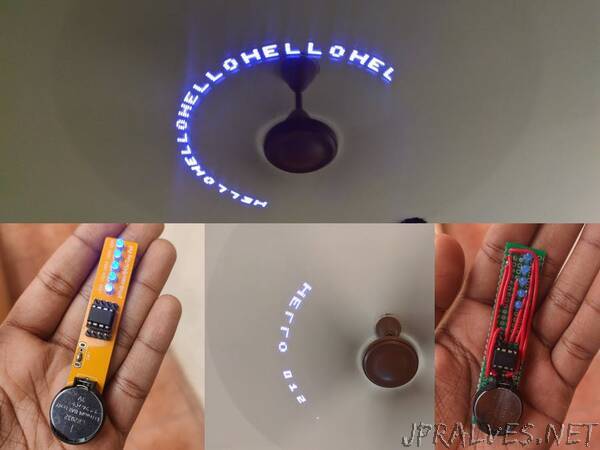
“Learn how to build a really cool persistence of vision display for $1.
Story
PoV Display with ATtiny13 for $1
I was browsing through AliExpress sometime back and this particular listing caught my attention.
5 Pcs of ATtiny13 microcontrollers for ₹124, that’s like $1.5.
That’s like $0.3 (₹25) per MCU.
Isn’t that amazing, a programmable microcontroller! for ₹25.
I googled “ATtiny13 Arduino” and yes, ATtiny13 is supported by Arduino. AWESOME.
So I immediately placed the order.AliExpress takes a heck load of time to deliver to India.I almost forgot that I even placed the order.After one month or so the package arrived.
ATtiny13 has limited library support, so I was not able to do anything with it, other than blink an LED.
A project that I did a long time ago came to my mind as I thought of what more I could do.It was a PoV display using ATtiny85.PoV Displays are basically a bunch of blinking LEDs with some carefully placed delay.Both ATtiny85 and ATtiny13 have the same pinout.
The total cost of the components for this project is under $1. If you are in India you can get the ATtiny Microcontroller from this link.
You will be needing these components for this project
1 x ATtiny13
5 x 3mm LEDs (5mm LED will also work, 3mm looks better as you can put them much closer in PCB)
1 x CR2032 Battery
1 x CR2032 Battery holder
1 x Slide Switch
Prototyping PCB or My Custom PCB
Soldering Iron
What are PoV Displays and how do they work?
According to Wikipedia, the Persistence of vision is the optical illusion that occurs when visual perception of an object does not cease for some time after the rays of light proceeding from it have ceased to enter the eye.
If you look at a normal display the pixels are arranged in a matrix fashion.But in a PoV display Pixels/LEDs are arranged as an array.How does it display anything you may ask, that’s where the Persistence of vision comes into play.Our eyes won’t be seeing different columns of LEDs, they would see what appears to be a proper image.”
